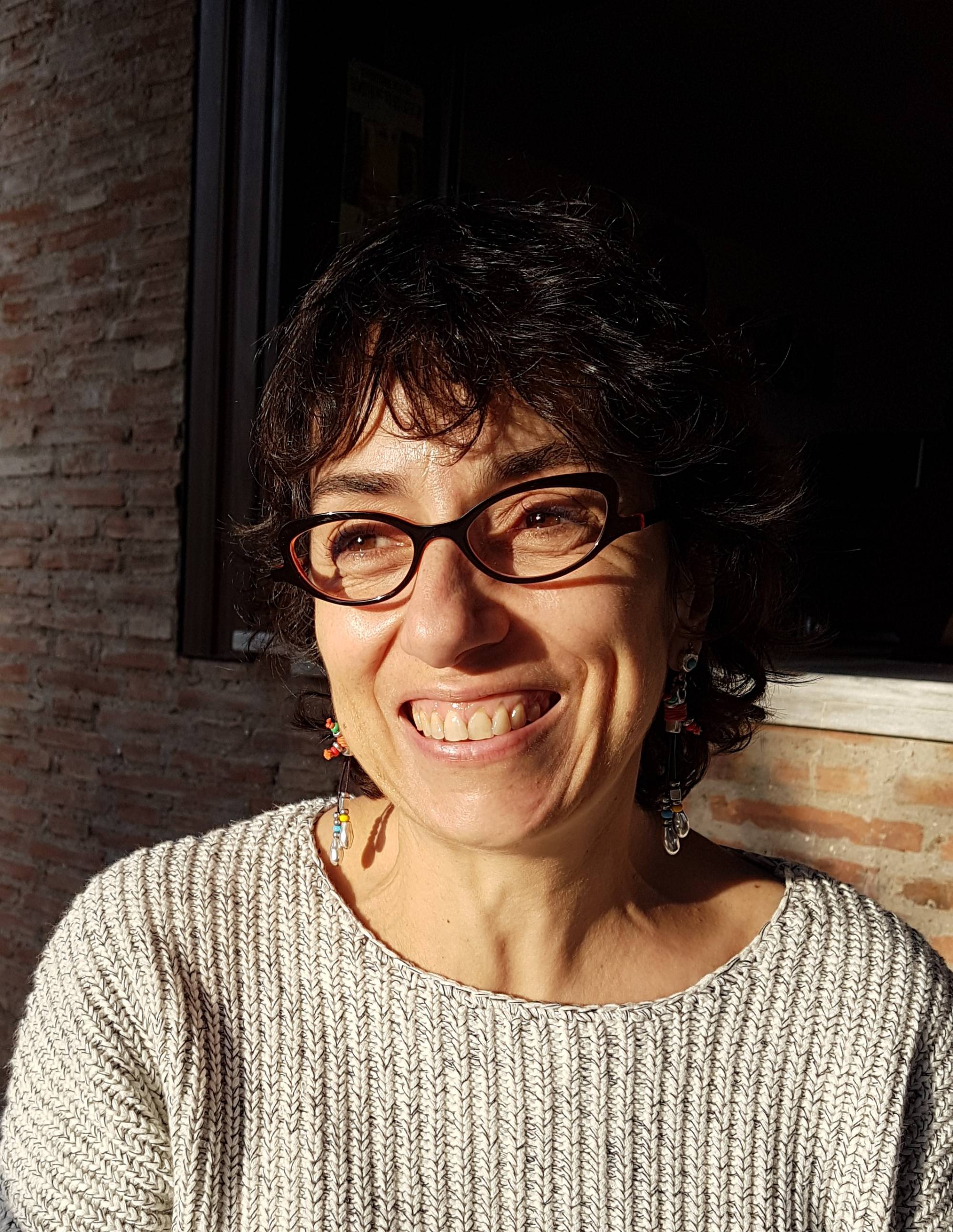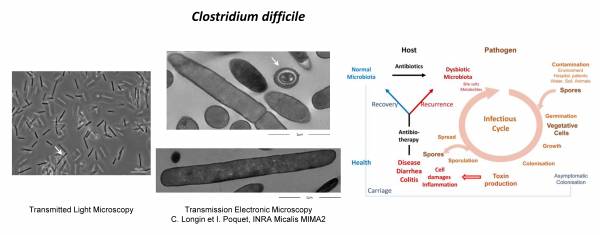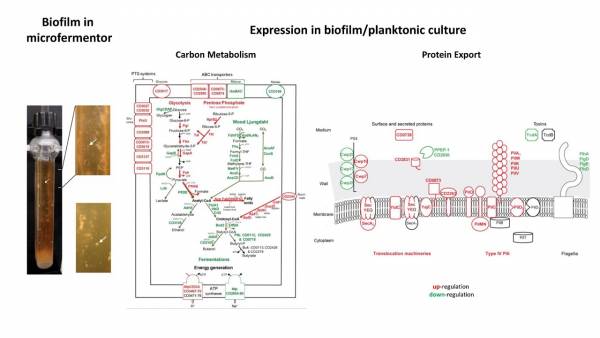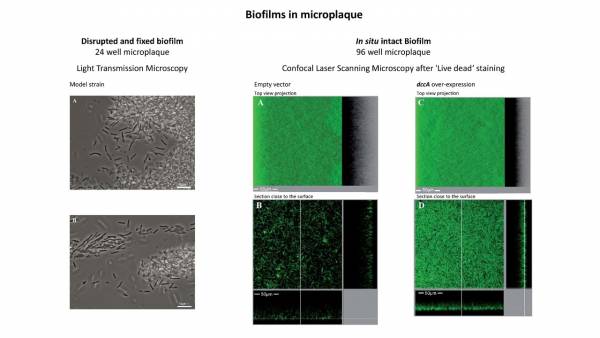Contact me :
E-mail: Isabelle Poquet
Téléphone: +33 (0)1 34 65 24 95
Clostridium difficile biofilms
In short …
Clostridium difficile is a spore-forming anaerobe and an enteric pathogen that represents a public health problem. After antibiotic treatments that alter the intestinal flora, it is able to cause colitis and diarrhea that are difficult to treat, recurrent and display a high mortality rate. We are studying the ability of C. difficile to form biofilms that could participate in colonization and persistence in humans and animals.
Context and challenges
Clostridium difficile is responsible for diseases ranging from simple diarrhea to severe forms, such as pseudomembranous colitis and toxic megacolon. In the US, 450,000 cases and 29,000 deaths were reported in 2011, and since 2013, C. difficile is, as an antibiotic-resistant pathogen, considered as an urgent threat. It is the leading cause of nosocomial diarrhea in France, with an estimated annual cost of € 163 million in 2011. C. difficile is also responsible for increasing community infections and antibiotic-associated diarrhea in most livestock. The spore is the infectious form of C. difficile. It easily disseminates in a hospital setting and more generally, it is ubiquitously present in the environment, in soil, water and food. The zoonotic potential of C. difficile infections is a question increasingly studied worldwide.
The infectious cycle of C. difficile is complex and has several stages. It begins by spore germination that is followed by vegetative cell growth and expansion. The infection culminates with the production of toxins that lead to symptoms, and sporulation lastly allows dissemination. The ability of C. difficile to colonize the gut is an important, yet still poorly understood, step of the infectious cycle. Since 2012, the scientific community is studying C. difficile biofilms as they may be involved in gut colonization and persistence, as well as in chronic and recurrent infections.
Key result: C. difficile forms biofilms of different architectures
Our team, in collaboration with others from the Pasteur Institute and the Micalis Institute of INRA, recently demonstrated that in vitro, under specific conditions, C. difficile is able to form biofilms that are different from already described ones. In micro-fermentors under a medium flow somehow mimicking the flow of fluids in the digestive tract, C. difficile grows as a macroscopic submersed biofilm and as macro-colonies. The comparison of gene expression between this biofilm and a conventional (planktonic) culture indicates an extensive reprogramming of both cell metabolism and protein export, including a low expression of toxins. These results suggest that the biofilm evidenced here, whose major function does not seem to be toxin production, might serve as an asymptomatic reservoir, either at an early stage of the infectious cycle or between recurrent infectious episodes. After growth in microplates, disruption and fixation, biofilm cells can be observed by microscopy to remain embedded into a polymorphic material. They form robust aggregates, which are not disrupted by harvesting and fixing treatments, and are similar in size to the ones recently described at the mucosal surface of epithelial cells in colonized mice (Soavelomandroso et al., 2017 Front Microbiol). In situ noninvasive labeling of the intact biofilm formed in the microplates reveals a high, sparse and heterogeneously structured three-dimensional architecture, containing both microaggregates and individual cells. This heterogeneous architecture is original compared to that of the C. difficile biofilms that have been described so far (Vuotto et al 2018 Adv Exp Med Biol; Pantaléon et al. 2014 Anaerobe; Dapa and Unnikrishnan 2013 Gut Microbes). It is relevant, as heterogeneity is a well-known property of biofilms formed by other species. This heterogeneous architecture could promote exchanges with the environment as well as the colonization of networked structures, such as mucus. Interestingly enough, this architecture is completely different from that obtained after induction of a gene that is over-expressed in the micro-fermentor biofilm, dccA. dccA is involved in the synthesis of c-di-GMP, a known messenger of biofilm formation in many species, including C. difficile. In C. difficile, dccA artificial induction at a very high level not only increases the amount of biofilms, as previously described (Soutourina et al 2013 Plos Genet), but also drastically modifies its architecture: the biofilm is homogeneous and dense and its thickness is low. These results demonstrate for the first time that C. difficile is able to form cell micro-aggregates and biofilms of different architectures, either homogeneous and dense, under conditions of strong induction of c-di-GMP production, or heterogeneous and sparse, under more physiological conditions.
Perspectives
All these results point to the role of C. difficile biofilms in infected humans or animals. In the future, we aim to study the different biofilms with respect to the mechanisms of their formation and their properties. The ability of biofilm cells to produce toxins and their resistance to antibiotics, either those used to treat C. difficile infections or those whose use represents a risk factor, should be evaluated. This research should lead to a better understanding of the role and importance of biofilms during the infectious cycle and could therefore help developing effective strategies against C. difficile infections.
References
- Poquet I (corresponding), Saujet L, Canette A, Monot M, Mihajlovic J, Ghigo J-M, Soutourina O, Briandet R, Martin-Verstraete I, Dupuy B. 2018 Clostridium difficile biofilm: remodelling metabolism and cell surface to build a sparse and heterogeneously aggregated architecture. Front Microbiol. Sep 12;9:2084. doi: 10.3389/fmicb.2018.02084. eCollection 2018.
- Maikova A, Peltier J, Boudry P, Hajnsdorf E, Kint N, Monot M, Poquet I, Martin-Verstraete I, Dupuy B, Soutourina O. 2018 Discovery of new type I toxin–antitoxin systems adjacent to CRISPR arrays in Clostridium difficile. Nucleic Acids Res. 46 (9), 4733-4751. DOI: 10.1093/nar/gky124
Collaborations
- Bruno Dupuy et Isabelle Martin-Verstraete, LPBA, Pasteur Institute, Paris
Starting this project, as decided by GME to diversify its research activities, has been made possible thanks to the opportunity given by INRA (MICA Department, Micalis Unit, GME Team) to Isabelle Poquet to be a sabbatical in Bruno Dupuy’s laboratory at the Pasteur Institute. The collaboration is on going to develop the project.
- Olga Soutourina, Paris-Saclay University, Orsay
- Jean-Marc Ghigo, Genetics of Biofilms Unit, Pasteur Institute, Paris
- Romain Briandet, B2HM, Micalis Institute, INRA, Jouy-en-Josas
- Alexis Canette, Julien Deschamp et Christine Longin, plateforme MIMA2, Micalis, INRA, Jouy-en-Josas
- Claire Janoir, Faculté de Pharmacie, Université Paris-Saclay, Châtenay-Malabry
Previous project: Lactococcus lactis, a cell factory to produce secreted proteins
In short...
Lactococcus lactis, is a dairy bacterium that is widely used in the food industry as starters to produce cheeses but also more recently as a cell factory in the biotechnology or heath fields. We developped, in L. lactis host, the production and secretion of proteins with high added value, as secreted forms that are easy to purify. We were therefore involved in both basic research on protein secretion and quality control, but also on applied research to improve the process and we were able to patent the use of several tools. We were able to efficiently produce proteins of biotechnological or medical interest, leading to a good yield of stable and acttive (or at least correctly folded) protein forms. Our patented technology allowed building industrial partnerships, with research and license contracts.
Bibliography
Articles
- Varela PF, Velours C, Aumont-Niçaise M, Pineau B, Legrand P, Poquet I. 2019 Biophysical and structural characterization of a zinc-responsive repressor of the MarR superfamily. PLoS One 14(2):e0210123. DOI: 10.1371/journal.pone.0210123
- Samazan F, Rokbi B, Seguin D, Telles F, Gautier V, Richarme G, Chevret D, Fernández Varela P, Velours C, Poquet I (corresponding). 2015 Production, secretion and purification of a correctly folded staphylococcal antigen in Lactococcus lactis. Microb. Cell Fact. Jul 16;14:104. DOI: 10.1186/s12934-015-0271-z
- Trémillon N, Morello E, Llull D, Mazmouz R, Gratadoux J-J, Guillot A, Chapot Chartier M-P, Monlezun L, Sole V, Ginisty H, Poquet I (corresponding). 2012 PpiA, a surface PPIase of the cyclophilin family in Lactococcus lactis. Plos One 7 (3):e33516. DOI: 10.1371/journal.pone.0033516
- Llull D, Son O, Blanie S, Briffotaux J, Morello E, Rogniaux H, Danot O, Poquet I (corresponding). 2011 Lactococcus lactis ZitR is a zinc-responsive repressor active in the presence of low, nontoxic zinc concentrations in vivo. J. Bact. 193 (8), 1919-1929. DOI: 10.1128/JB.01109-10
- Trémillon N, Issaly N, Mozo J, Duvignau T, Ginisty H, Devic E, Poquet I. 2010 Production and purification of staphylococcal nuclease in Lactococcus lactis using a new expression-secretion system and a pH-regulated mini-reactor. Microb. Cell Fact. 9 :37. DOI: 10.1186/1475-2859-9-37
- Morello E, Bermudez Humaran L, Llull D, Solé V, Miraglio N, Langella P, Poquet I (corresponding). 2008 Lactococcus lactis, an efficient cell factory for recombinant protein production and secretion. J. Mol.Microbiol. Biotechnol. 14 (1-3), 48-58. DOI: 10.1159/000106082
Patents
- Poquet I, Gruss A, Bolotine A, Sorokine A. Gram positive bacteria deprived of HtrA protease activity and their uses. Patent in France (FR2787810), Europe (EP 1141337) and US (US 6,994,997).
- Poquet I, Llull D. Prokaryotic zinc-controlled expression cassettes. Patent in France (FR 2843973), Europe (EP 1 537 215) and in the US (US 8,354,272).
- Poquet I, Ogier J-C, Leroy S. Method to identify the species of a bacterial strain from Staphylococcus genus. Patent N° 09 52773 in France (FR 2 944 807)
Network
Industrial partnerships
- Bachra Rockbi, Sanofi Pasteur, Lyon: Research Contract (18 months)-Production and secretion of two recombinant antigens by L. lactis
- Hervé Ginisty and Eric Devic, GTP-Technology, Labège: Two Research Contracts and CIFRE grants for PhD students (3 years each), Licensing and sub-licensing contracts (yearly)-Protein quality control at the cell surface of and efficient production of secreted proteins in L. lactis
Academic collaborations
- Paloma Fernandez Varela, SOLEIL Synchrotron, Saint-Aubin
- Gilbert Richarme, Jacques Monod Institute, Paris 7 University
- Marie-Pierre Chapot-Chartier, Micalis Institute, INRA, Jouy-en-Josas
Training
- Frédéric Samazan, Ingeneer
- Nicolas Trémillon, PhD
- Eric Morello, PhD
- Daniel Llull, Post-doc, Marie-Curie fellowship




